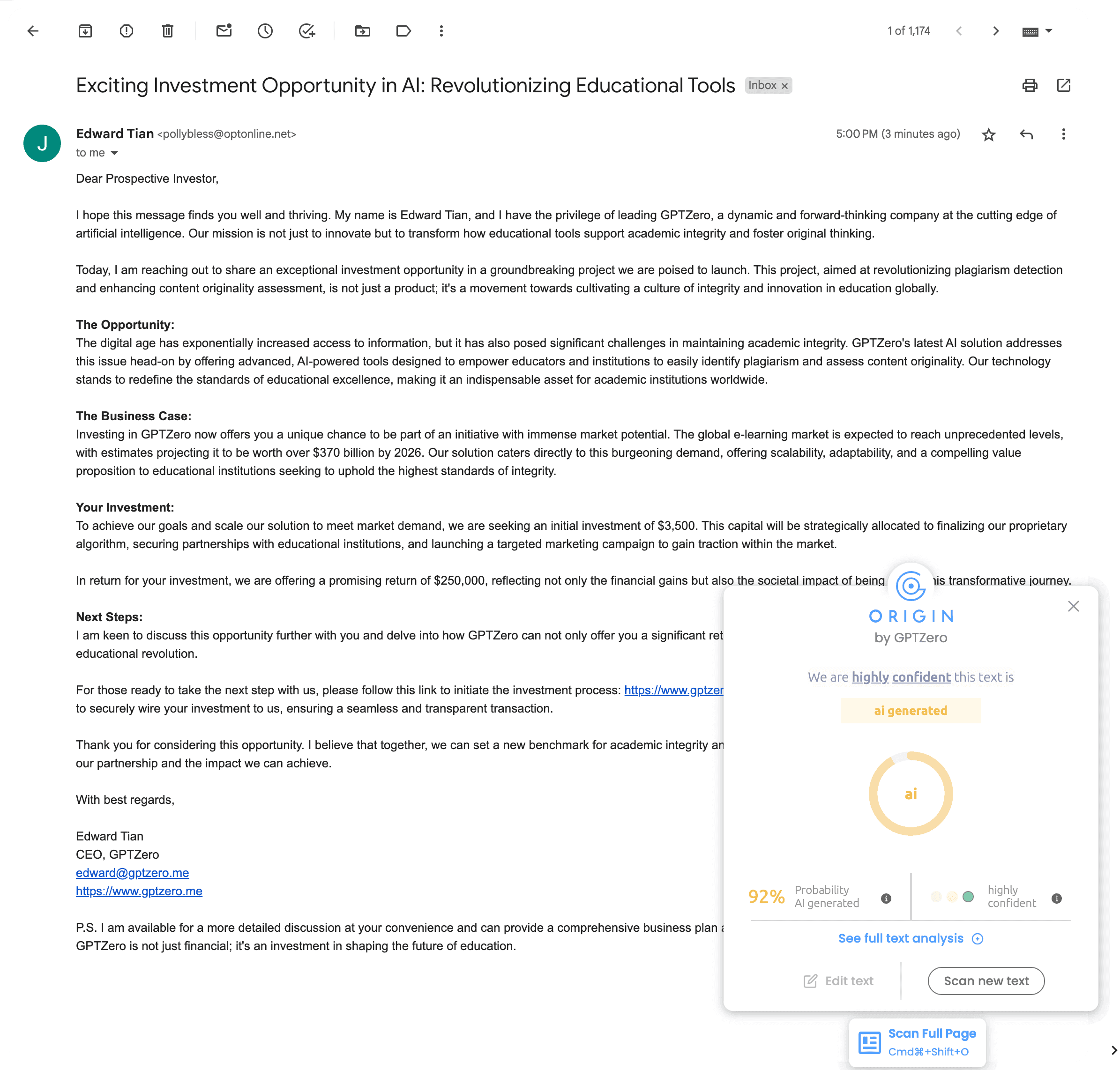

Can you tell this is a phishing email?

We can.
No matter what channel you’re trying to guard, whether it’s email, form submissions, or anything else, we can detect whether what you’re reading was written by a human or if it warrants further scrutiny.
curl --request POST
--url https://api.gptzero.me/v2/predict/text
--header 'Accept: application/json'
--header 'Content-Type: application/json'
--header 'x-api-key: '
--data '{
"document": "string",
"version": "string"
}'Compliance

GPTZero reviews
“The best AI checker"according to our customers and communityGPTZero was the only consistent performer, classifying AI-generated text correctly. As for the rest … not so much.
GPTZero has been incomparably more accurate than any of the other AI checkers. For me, it’s the best solution to build trust with my clients.
This tool is a magnifying glass to help teachers get a closer look behind the scenes of a document, ultimately creating a better exchange of ideas that can help kids learn.
The granular detail provided by GPTZero allows administrators to observe AI usage across the institution. This data is helping guide us on what type of education, parameters, and policies need to be in place to promote an innovative and healthy use of AI.
After talking to the class, each student we compiled with GPTZero as possibly using AI ended up telling us they did, which made us extremely confident in GPTZero’s capabilities.
Sign up for GPTZero. Its feedback aligns well with my sense of what is going on in the writing - almost line-for-line.
I'm a huge fan of the writing reports that let me verify my documents are human-written. The writing video, in particular, is a great way to visualize the writing process!
Excellent chrome extension. I ran numerous tests on human written content and the results were 100% accurate.
Outstanding! This is an extraordinary tool to not only assess the end result but to view the real-time process it took to write the document.
GPTZero is the best AI detection tool for teachers and educators.
FAQs about GPTZero
Everything you need to know about GPTZero and our ChatGPT detector.
Can’t find an answer? You can talk to our customer service team.
How does GPTZero detect AI-generated text?
GPTZero uses deep learning models that keep pace with AI advancements to deliver precise, reliable results that help you understand and interpret the origin of a piece of text. A sentence-by-sentence classifier calculates the probability that a text was created by AI, giving you both document-level and granular insights.
How accurate is GPTZero at detecting AI text?
Independent and internal benchmarking show that GPTZero outperforms competitors at detecting mixed documents (where both AI and human writing has been used) with 96.5% accuracy. Our false positive rate is under 1%, making it one of the most reliable detectors available.
Can GPTZero detect text from the latest AI models?
Yes. GPTZero is continually updated to recognize text from the newest large language models, including ChatGPT (GPT-3, GPT-4, GPT-5), Google Gemini, LLaMA, Claude, and others. As new models are released, we adapt and update our detection system.
How does GPTZero reduce false positives, especially for ESL students?
Since 2022, we've focused on reducing bias for ESL (English as a Second Language) writers. By tagging educational data, adding representative datasets, and using text pre-classification, we've reduced the false positive rate on TOEFL essays to just 1.1%.
How does GPTZero handle paraphrased or modified AI content?
Many try to bypass AI detectors by paraphrasing or using homoglyph substitutions. Our model's Paraphraser Shield technology is designed to catch these cases. Even if AI content has been altered to look more human-like, GPTZero can detect it.
What are the known limitations of AI detection?
No AI detector is 100% accurate, and AI itself is changing constantly. GPTZero performs best of longer texts and English prose. We encourage using it as a conversation starter, and not as the final verdict. GPTZero is the only detector specifically de-biased for ESL writers, lowering false positives to 1%.
What data did you train your model on?
Our model is trained on millions of documents spanning various domains of writing including creating writing, scientific writing, blogs, news articles, and more. We test our models on a never-before-seen set of human and AI articles from a section of our large-scale dataset, in addition to a smaller set of challenging articles that are outside its training distribution.
How do I use and interpret the results from your API?
When you run text through our API, you'll see a document_classification field that labels it as HUMAN_ONLY, MIXED, and AI_ONLY. Each classification comes with probabilities (via the class_probabilities field) and a confidence_category field, which can be high, medium, or low. When the confidence is "high", error rates are below 1%. The API provides sentence-level highlights (API users can access this highlighting through the highlight_sentence_for_ai field) so you can see exactly which parts of the text contributed most to the classification.
Are you storing data from API calls?
No. We do not store or collect the documents passed into any calls to our API. For dashboard users, only aggregate inputs are stored to improve the service. See our privacy policy for full details.
